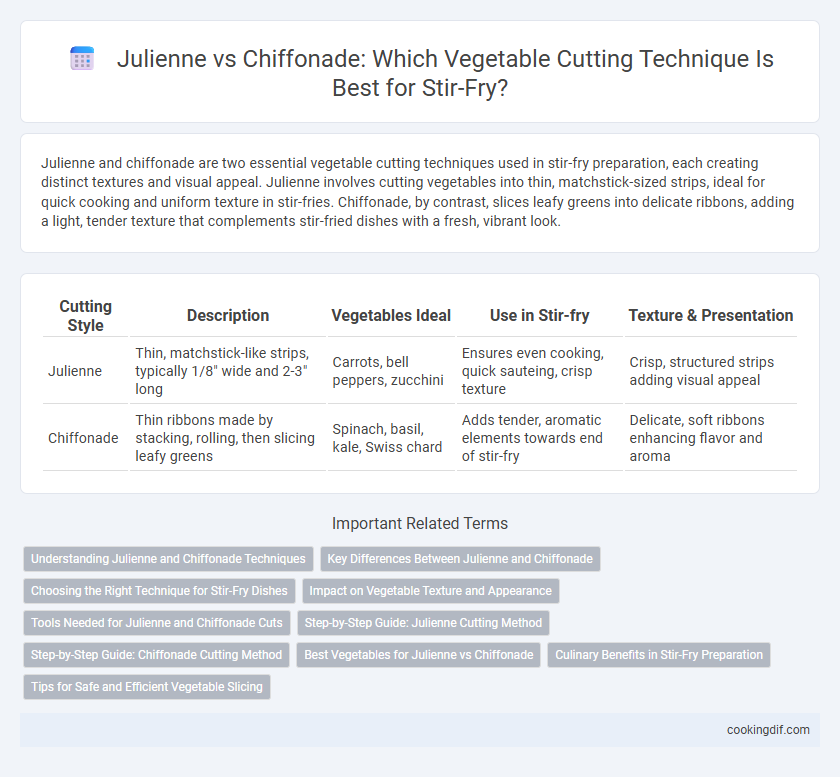Julienne and chiffonade are two essential vegetable cutting techniques used in stir-fry preparation, each creating distinct textures and visual appeal. Julienne involves cutting vegetables into thin, matchstick-sized strips, ideal for quick cooking and uniform texture in stir-fries. Chiffonade, by contrast, slices leafy greens into delicate ribbons, adding a light, tender texture that complements stir-fried dishes with a fresh, vibrant look.
Table of Comparison
| Cutting Style | Description | Vegetables Ideal | Use in Stir-fry | Texture & Presentation |
|---|---|---|---|---|
| Julienne | Thin, matchstick-like strips, typically 1/8" wide and 2-3" long | Carrots, bell peppers, zucchini | Ensures even cooking, quick sauteing, crisp texture | Crisp, structured strips adding visual appeal |
| Chiffonade | Thin ribbons made by stacking, rolling, then slicing leafy greens | Spinach, basil, kale, Swiss chard | Adds tender, aromatic elements towards end of stir-fry | Delicate, soft ribbons enhancing flavor and aroma |
Understanding Julienne and Chiffonade Techniques
Julienne and chiffonade are essential vegetable cutting techniques for stir-fry dishes, each producing distinctive textures and presentation styles. Julienne involves slicing vegetables into thin, matchstick-like strips, promoting even cooking and quick heat absorption, ideal for bell peppers, carrots, and zucchini. Chiffonade, typically used for leafy greens and herbs, entails stacking, rolling, then finely slicing leaves into thin ribbons, enhancing delicate flavors and adding a light, airy texture to the dish.
Key Differences Between Julienne and Chiffonade
Julienne and chiffonade are two distinct vegetable cutting techniques used in stir-fry preparation, each serving different purposes and visual effects. Julienne produces uniform, thin matchstick-like strips ideal for quick, even cooking and crisp texture, commonly applied to root vegetables and peppers. Chiffonade involves rolling leafy greens or herbs into tight bundles and slicing them into delicate ribbons, enhancing both presentation and flavor integration in stir-fry dishes.
Choosing the Right Technique for Stir-Fry Dishes
Julienne cuts create thin, matchstick-like strips ideal for quick, even cooking in stir-fry dishes, enhancing texture and visual appeal. Chiffonade produces delicate, ribbon-like slices perfect for leafy greens, allowing them to wilt evenly without overpowering other ingredients. Selecting julienne for firmer vegetables and chiffonade for tender greens optimizes cooking times and flavor balance in stir-fry recipes.
Impact on Vegetable Texture and Appearance
Julienne cuts create thin, uniform strips that cook quickly and maintain a crisp texture, ideal for stir-frying vegetables like bell peppers and carrots to preserve their vibrant appearance. Chiffonade involves slicing leafy greens into delicate ribbons, which soften rapidly and blend seamlessly into dishes, enhancing visual appeal through a layered, feathery texture. Choosing between julienne and chiffonade directly impacts the stir-fry's texture contrast and overall presentation by controlling cooking time and how the vegetables integrate visually.
Tools Needed for Julienne and Chiffonade Cuts
Julienne cuts require a sharp chef's knife or mandoline slicer to create uniform, thin matchstick-like strips, optimizing cooking speed and texture in stir-fry dishes. Chiffonade cutting demands a sharp knife and a stable cutting board to finely slice leafy greens or herbs into delicate ribbons, preserving their flavor and appearance. Selecting the right cutting tools enhances precision and efficiency, crucial for achieving the desired vegetable texture in stir-fry recipes.
Step-by-Step Guide: Julienne Cutting Method
Julienne cutting involves slicing vegetables into uniform matchstick-sized strips, typically 1/8 inch by 1/8 inch by 2-3 inches long, ideal for stir-fry due to even cooking and quick heat penetration. Start by trimming the vegetable's ends, then cut into manageable sections, slice each section lengthwise into thin planks, and finally stack and cut those planks into thin, consistent sticks. This method contrasts with chiffonade, which is best for leafy greens and herbs, emphasizing texture rather than uniform cooking speed.
Step-by-Step Guide: Chiffonade Cutting Method
Chiffonade cutting method involves stacking leafy vegetables or herbs, rolling them tightly into a cigar shape, and slicing across the roll into thin ribbons ideal for stir-fry garnishes or quick-cooking greens. Julienne, by contrast, produces long, matchstick-sized strips best suited for crisp vegetables like bell peppers or carrots, enhancing texture in stir-fries. Mastering chiffonade ensures uniform thickness, promotes quick cooking, and releases maximum flavor from herbs and delicate leaves integral to vibrant stir-fry dishes.
Best Vegetables for Julienne vs Chiffonade
Best vegetables for julienne cutting include carrots, bell peppers, zucchini, and cucumbers, as their firm texture and shape hold well during stir-frying. Chiffonade is ideal for leafy greens like basil, spinach, and kale, allowing delicate herbs and tender leaves to retain flavor and absorb sauces effectively. Choosing the right cut enhances texture and presentation, optimizing the cooking process and final dish quality in stir-fry recipes.
Culinary Benefits in Stir-Fry Preparation
Julienne cutting produces thin, matchstick-sized vegetable strips that cook quickly and evenly in stir-fry dishes, enhancing texture and ensuring uniform heat distribution. Chiffonade slicing creates delicate, ribbon-like strands ideal for leafy greens and herbs, allowing them to wilt rapidly and blend seamlessly with other ingredients. Both techniques optimize cooking time and flavor release, elevating the overall stir-fry experience by balancing crispness and tenderness.
Tips for Safe and Efficient Vegetable Slicing
Julienne and chiffonade are essential vegetable cutting techniques for stir-fry, each offering distinct textures and cooking times; julienne creates thin, matchstick-like strips ideal for quick cooking, while chiffonade produces delicate, ribbon-like slices best suited for leafy greens. Use a sharp knife to maintain control and prevent slipping, always employing a claw grip to shield fingers from the blade. Consistent cutting thickness ensures even cooking, enhancing both flavor and presentation in your stir-fry dishes.
julienne vs chiffonade for vegetable cutting Infographic

 cookingdif.com
cookingdif.com